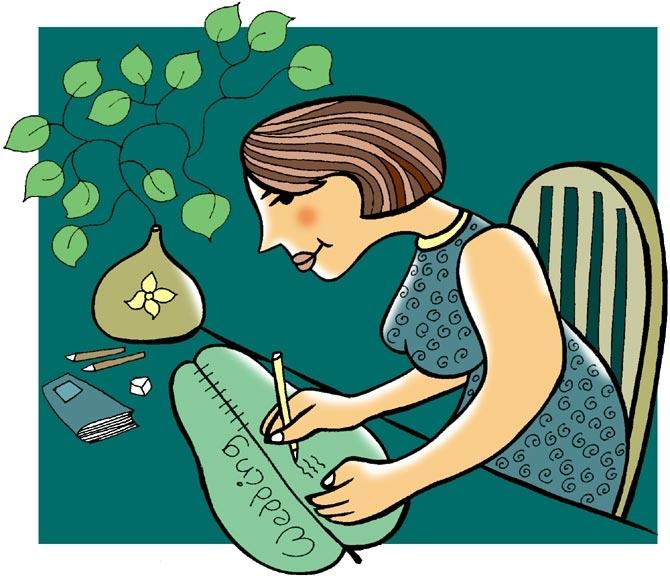
In her next entry, Divya Nair discusses some events from her life that have made her realise how difficult it is to please everyone and why it is important to learn to take things in the right spirit and move on.
You know what’s the best part of having a love marriage arranged by parents?
It’s facing the people who have unintentionally given you a bad time, with a straight face. More importantly, it teaches you to be patient and brings you closer to your family.
In the last three years, every time Amma stepped out for grocery shopping or to attend a social gathering, she was faced by seemingly concerned aunties (read gossip mongers) who would pop the ultimate, universe-altering question: When is your daughter getting married?
Some of those aunties and uncles who had earlier come home to invite us for their own child’s marriage, would add insult to injury by sharing news of how they’d turned grandparents, silently reminding my own parents that they were probably taking things too lightly.
You don’t have to be an Einstein to decode that their intention was solely to make my Amma feel more sorry, and less proud, of her own daughter.
I have lost count of the times I have sympathised with Amma whose polite excuse was that we were waiting for my younger brother -- who is in the merchant navy and travelling away from home for his training -- to return.
Had it not been for the love and bonding between us as a family, overcoming these tiny hurdles would have been difficult.
Our society still hasn’t graduated to welcome the concept of an inter-caste or love marriage. My parents and I have had to suffer people who, in the middle of the road, in the grocery shop, at someone else’s wedding, have volunteered needless gyaan about how the current generation devalues morals, culture and parents.
If they acknowledged my presence, someone would be kind enough to add: At least you informed your parents and sought their consent. You know X eloped with Y without informing their parents.
Dearest aunties and uncles, I’m glad for all the love and concern you’ve shown toward my family and me in the last few years.
In fact, you’d be happy to know that all your kind prayers have been answered. I’m finally getting married and you’re all invited.
Last month, we printed our first set of wedding cards and even in these times of e-mails and Internet, the 10” x 7” piece of paper (that would eventually occupy a snug place in someone’s trashcan), brought along a different feeling of excitement.
Being in a creative profession, I had taken help from one of my art designer friends and a senior photographer who helped me execute the idea of printing the invitation on a banana leaf.
Here, I must admit that finalising the font, paper and design did not take as much time as finalising the text did.
It took us almost two weeks to finalise the text for the invitation.
If you are wondering what took us so long, let me share with you a few learning experiences from my friends.
I had to take extra care to get the names and spellings right. In the case of some of my friends, the groom in question was upset that the bride’s invitation card had mentioned his name as ‘Shekhar’ instead of Sekar.
Another friend had to reprint the whole set of cards because they had failed to add Kumar next to the groom’s name.
An incident that led to a huge quarrel between the two families was when the bride’s invitation card had the following details about the groom’s family: Ramasubramaniam, son of Late Kamala Iyer and Vighneshwaran Iyer.
The groom’s father objected to the positioning of the word ‘Late’. He said that it seemed to suggest that both the groom’s parents were no more.
Then there is the tradition in southern India, where the matriarchal system is followed, and the wedding invitation mentions the name of the wife before the husband. For example, Divya Nair, daughter of Manjula Nair and Ramanunni Nair, instead of vice versa.
At one point my parents had even considered dropping the surnames Nair and Shetty, but eventually let it stay in some places.
After two weeks of back and forth, correcting and perfecting every tiny detail in the copy, I was confident that there was no scope for error.
Last week, as I was silently rejoicing in the compliments I received over the design of the card, someone asked me whose idea it was to print it on a banana leaf.
“Don’t you know that in Kerala, a single banana leaf is meant to cover the body of a dead person? How can you associate it with a wedding?”
None of us had thought about it, and immediately a lot of excuses went through my mind, including how banana leaf was synonymous with a wedding feast.
I wanted to emphasise that it was, after all, just coloured paper designed like a banana leaf and not an actual banana leaf.
But I soon realised that no matter how much care one took, one would end up disappointing someone or the other.
You just have to learn to take things in your stride and move on to other important things.
Don't miss Divya's previous columns:
'Have you bought enough gold?'
'Arranged marriage seemed like a box of lies waiting to explode'